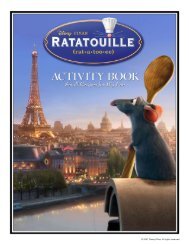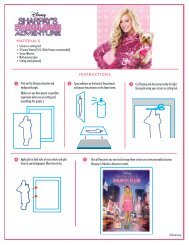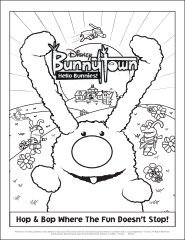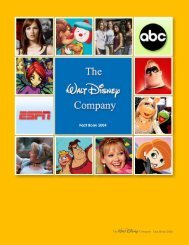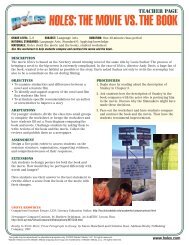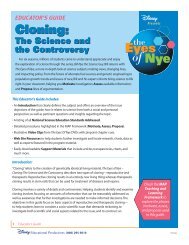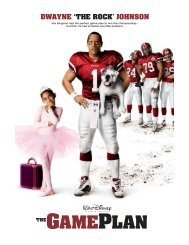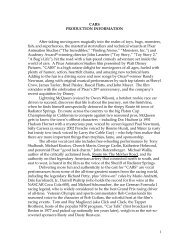introduction - Disney
introduction - Disney
introduction - Disney
You also want an ePaper? Increase the reach of your titles
YUMPU automatically turns print PDFs into web optimized ePapers that Google loves.
L I T E R A T U R E - B A S E D A C T I V I T I E S<br />
Music and America<br />
Many of the characters in America’s Heart & Soul are musicians and the film offers an<br />
array of musical styles:<br />
The following activities ask students to re-examine a piece of writing,<br />
question its values or issues and then relate the text to the film. However,<br />
one does not have to be an English teacher to spark conversations about<br />
these texts and their relevance to America’s Heart & Soul.<br />
Characters<br />
Musical Genre<br />
The Climates of the Country<br />
In his 1782 work Letters from an American Farmer, Hector St. John De Crevecoeur asks,<br />
“What is an American?” Have your students meet in teams of 4 or 5 and brainstorm some<br />
possible answers to the question and then present their ideas to the class. After each team<br />
has presented, distribute copies of Handout 1: Crevecoeur’s Response and ask the class to<br />
compare and contrast his reply with theirs.<br />
You will notice that Crevecoer’s response reflects the tenor of his times (he only mentions<br />
emigration from Europe) but also, in his optimism, the spirit of our own—and that which is<br />
found throughout America’s Heart & Soul.<br />
After the class discussion, have students explain (again in groups or in writing) how<br />
America’s Heart & Soul responds to the same question: According to the film, what qualities do<br />
Americans share? What do they value? How does the film explore the importance and<br />
significance of the “different climates” that Americans currently “inhabit”—whether these<br />
climates are literal (as with Paul Stone or Minnie Yancy) or more figurative (as with Michael<br />
Bennet or Reverend Cecil Williams)? Ultimately, you may want to have your students compose<br />
their own “Letters from an American Teenager” in which they describe what they find to be<br />
the current American values and assumptions.<br />
Marc and Ann Savoy<br />
Mosie Burks<br />
George Woodard<br />
Frank and Dave Pino<br />
James and Troy Andrews<br />
Danielle de Niese<br />
David Krakauer<br />
The Vasquez Family<br />
Cajun<br />
Gospel<br />
Bluegrass<br />
Rock and Roll<br />
Jazz<br />
Opera<br />
Klezmer<br />
Salsa<br />
However, the film never “votes” on which style is the most relevant or meaningful: the point<br />
is, of course, that each style of music speaks in different ways to those who have made it<br />
their passion. Ask students to identify all of the types of music that can be heard in America<br />
today—and to also identify as many sub-genres of the types as they can. Then begin a<br />
discussion of why director Louis Schwartzberg would include so much music in a film about<br />
America and how their favorite kinds of music reflect their personalities and passions.<br />
. The Songs of Americans at Work<br />
Many segments of America’s Heart & Soul glorify work and the people who do it; some of<br />
these jobs are relatively common (such as a dairy farmer or bike messenger) while others are<br />
more removed from the mainstream (such as a horse wrangler or oil-well firefighter).<br />
In his 1855 collection Leaves of Grass, the poet Walt Whitman offered his readers his<br />
appreciation for the workers of America. Distribute copies of Handout 2: Whitman and Work<br />
and have the students read Whitman’s poem “I Hear America Singing.” (You may want to have<br />
them first read it to themselves and then in a “choral reading” as a group.)<br />
Next, begin a conversation about the poem: what kinds of jobs does Whitman glorify here?<br />
How is working like singing—why would Whitman choose to examine labor in this light? How<br />
is the joy of music analogous to the joy of doing a job one loves? How does Schwartzberg’s film<br />
“sing” of those who love what they do, many of whom are, literally, musicians? Finally, have<br />
students compose their own poems: they can write imitations of Whitman in which they use<br />
occupations from the film or the ones that are performed in their own towns, states or regions<br />
of the country.<br />
9 10






